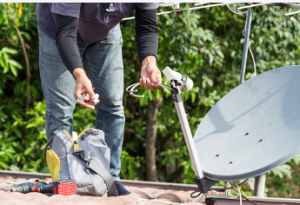How to Set Up an Antenna
If you’re planning on getting a TV antenna set-up for your home, you’ll first want to choose the right location. The optimal location will be near a window or a coax cable. Depending on the type of antenna you’re installing, you may also need to set up a home networking system. If you’re not familiar with these concepts, keep reading. This article will discuss two of the most common mistakes people make when installing a TV antenna.
 Before installing an antenna, make sure you’ve already determined the type of TV. If your TV has an antenna connection, you’ll need a wall plate to plug the cable into. A good antenna installer will make sure the plate is attached securely. After setting up the antenna, make sure to test the reception and signal strength to make it clear. In some cases, an amplifier may be necessary. Again, a professional antenna installer will be able to offer you a variety of options.
Before installing an antenna, make sure you’ve already determined the type of TV. If your TV has an antenna connection, you’ll need a wall plate to plug the cable into. A good antenna installer will make sure the plate is attached securely. After setting up the antenna, make sure to test the reception and signal strength to make it clear. In some cases, an amplifier may be necessary. Again, a professional antenna installer will be able to offer you a variety of options.
Another important aspect of TV antenna set-up installation is the mounting of the antenna. Whether you opt for an outdoor antenna or a window-mounted antenna, you’ll need to find a sturdy mast that fits the space and is above the roofline. Alternatively, you can attach a standalone mast to the soffit and mount it directly on the roof. If you opt for a window-mounted antenna, make sure it’s higher than the roofline and point it toward the towers.
The location of the antenna is equally important. It should be 10 to 20 feet above the ground, ideally above trees or other structures that can block the signal. Also, it should be mounted as high as possible and away from obstacles. You can use a signal meter to verify that your antenna aligns with the signal tower. Another important factor in antenna installation is polarisation. It is critical because the polarisation of the signal and antenna elements should match each other.
While setting up an antenna, remember to use the proper cables and hardware. The coax cable must be properly insulated and inserted into the antenna. A coaxial cable can also be used. Make sure the connectors are snug and grounded. It will ensure optimal protection against lightning strikes. You’ll need to connect your coax cable to your TV when you are done. And be sure to check the model number on your TV before starting any work.
You can check the FCC DTV map tool to see which channels are available in your area. The FCC DTV map can help you with the antenna selection. You should also consider the location of your home. Depending on your location, a higher antenna will provide a cleaner air connection to the tower. An outdoor antenna is best for homes not more than 10 feet from the ground. Then, determine the best location to install the antenna.
If you live in a city, you can choose a city that has a signal booster. Then, you can choose an antenna with a built-in rotator. Another option is to buy a TV antenna that doesn’t have a built-in rotator. A good example of this is the Vansky Outdoor Amplified HD Antenna. However, some antennas require you to purchase a separate rotator. You should know how to install one if you plan to use one.
When installing an outdoor antenna, it’s vital to understand where the signal comes from. Make sure you understand where the transmitter is located, as this will affect the direction of the signal. You may have to reposition your antenna if there are tall buildings near your home. When installing an antenna, you should also check if any obstructions might prevent it from receiving a signal. Then, follow local rules when grounding your new antenna.
Indoor antenna installation can also be problematic. The antenna set-up is often much lower than roof-mounted ones, limiting line-of-sight. The walls also reduce the digital signal. Try to install them as close to a window as possible. These antennas can pick up a signal in many locations but aren’t recommended for rural areas. For this reason, it is best to hire a professional. This way, you’ll get the best picture quality possible.